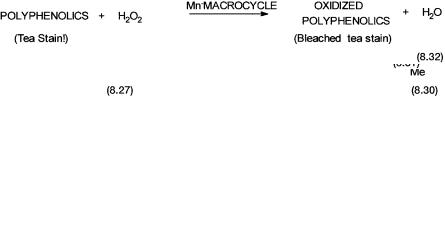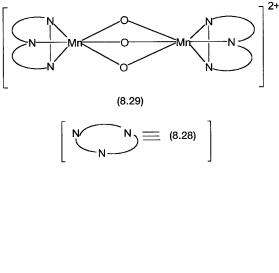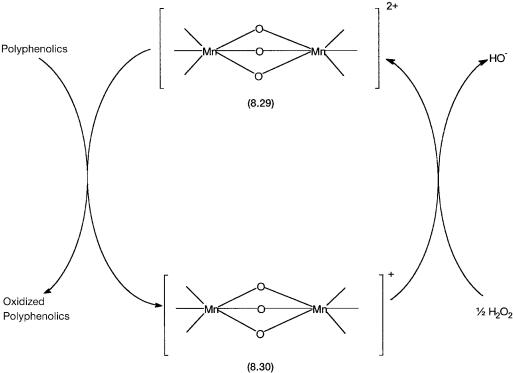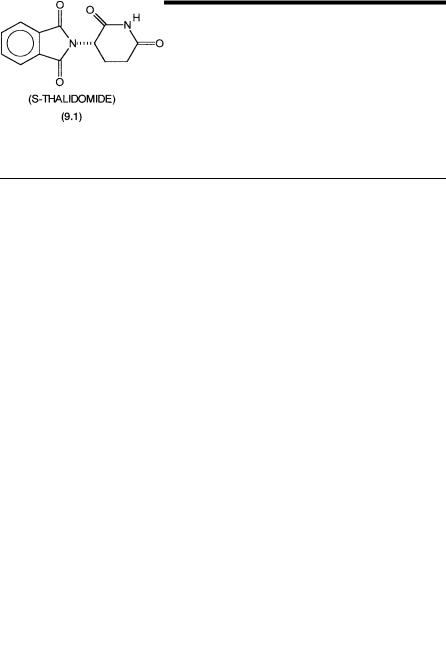
Homogeneous Catalysis
.pdf
186 OXIDATION
nation by the alkene as shown for 8.25. Metallocyclic complexes of Ti, V, or Mo of the type 8.26 have not been isolated, nor is there any spectroscopic evidence to suggest their involvement.
Unfortunately the macroscopic rate law cannot differentiate between Path A and Path B. The rate law in this and other related epoxidations is found to be
Rate = k[catalyst][alkene][hydroperoxide]
All the evidence taken together suggest possible coordination by propylene as in 8.25, but conversion of 8.25 directly to 8.24. In other words, there is no evidence for the involvement of a species such as 8.26. In asymmetric epoxidation of allylic alcohols, to be discussed in the next chapter, the alkene coordinates to the metal ion through the oxygen lone pair rather than the C–C double bond.
8.6 OXO COMPLEXES AS HOMOGENEOUS OXIDATION CATALYSTS
Metal complexes combined with a suitable oxygen atom donor can often act as versatile and selective oxidation catalysts. The oxygen atom donors commonly used are N-methyl morpholine oxide 8.27 (see reaction 8.30), organic hydroperoxides, sodium hypochlorite, hydrogen peroxide, etc. Three such reactions of industrial relevance are shown by 8.30, 8.31, and 8.32. Obviously these reactions are catalytic with respect to the metal complex but stoichiometric with respect to the oxygen atom donor.
The first reaction, 8.30, is the classical alkene dihydroxylation with osmium tetroxide. In recent years the potential of this reaction has been vastly extended

OXO COMPLEXES AS HOMOGENEOUS OXIDATION CATALYSTS |
187 |
by making asymmetric catalytic dihydroxylation possible (see Section 9.4). The second reaction, 8.31, is an epoxidation reaction that does not involve organic hydroperoxide and high-valent metal ions such as Ti4 , V5 , or Mo6 .
The importance of this reaction also lies in the fact that asymmetric epoxidation of alkenes other than allylic alcohols is possible with this catalytic system (see Section 9.3.4). The third reaction relates to catalysts developed by Unilever for improved detergent action in the presence of hydrogen peroxide. The important point to note is that catalytic intermediates with metal-oxo groups play a pivotal role in all these reactions.
Apart from potential industrial applications, homogeneous catalytic systems with metal–oxo intermediates have direct relevance to certain biological oxidation reactions. The biological reactions involve metalloenzymes such as Cyt P450, which has an iron–porphyrin complex in its active site. The enzyme catalyzes hydroxylation of a hydrocarbon by oxygen. This hydroxylation does not proceed through a radical-chain mechanism. There is sufficient evidence to indicate that a catalytic intermediate with an Fe—O group is responsible for the hydroxylation reaction.
8.6.1Mechanism of Oxidation by Oxo Compounds
Mechanisms of reactions 8.30 and 8.31 are discussed in the next chapter. The mechanistic details of the Unilever reaction are unknown, but some interesting observations have been reported. The ligand 1,4,7-trimethyl-1,4,7-triazacy- clononane 8.28 have been found to be particularly effective in forming manganese complexes that are active catalysts for reaction 8.32. One such complex is shown by 8.29.
188 OXIDATION
A tentative mechanism for the enhanced bleaching ability is shown by Fig. 8.6. Polyphenolics are largely responsible for tea stains. Complex 8.29 has both the manganese ions in 4 oxidation states. When used in a detergent formulation, it oxidizes the polyphenolics and is reduced to a species containing one Mn4 and one Mn3 ion. This species is tentatively formulated as 8.30. The hydrogen peroxide generated in situ by the detergent probably oxidizes 8.30 back to 8.29. There is good spectroscopic (ESR) evidence for the formation of a species such as 8.30. In the absence of 8.29 bleaching (i.e., oxidation of polyphenolics) does take place, but it is considerably slower than the rate of bleaching in its presence.
The development and commercialization of 8.29-type catalysts in detergent formulations have an interesting history. The invention has been covered by more than 30 patents and estimated to have incurred a developmental cost of more than 150 million dollars. The performance of the detergent and its effect on fabrics have been the subject of litigation between Unilever and Proctor & Gamble. The current status is that the use of manganese catalyst-containing detergents is restricted to special areas.
8.7ENGINEERING AND SAFETY CONSIDERATIONS
Liquid-phase oxidation reactions are generally carried out in a continuous stirred tank reactor by blowing pure oxygen or air at a pressure higher than the reactor operating pressure. The oxygen concentration in the gas phase at the top of the reactor must be below the flammability limit. As a further safety, the oxygen concentration is maintained below 5%. Because of these restrictions the volumetric production is generally low. Also, to reduce the gas and hydrocarbon vapor accumulation, these reactions are designed with very low headspace. When air is used as the oxidizing agent, the nitrogen carries liquid reactants, solvent, and products out of the reactor through the reactor vent, which needs to be recovered in a scrubber.
Organic peroxides are generally very unstable and can decompose spontaneously and explosively under thermal and mechanical stress. Such decomposition may be caused by shock, impact, friction, or by the catalytic effect of impurities. To reduce hazards involved during transportation and handling, they are desensitized by the addition of inert inorganic solids or liquids like water, halogenated hydrocarbons, etc. A solution of 70% t-butyl hydroperoxide has a self-accelerating decomposition temperature of 88 C. The acidity of hydroperoxides is greater than that of the corresponding alcohols. In many cases salts can be prepared that can be isolated and purified from the reaction mixture.

189
Figure 8.6 Catalytic cycle proposed for accelerated bleaching by manganese complex-containing detergent. For clarity the ligand environment around the Mn atoms are not shown in detail.
190 OXIDATION
PROBLEMS
1.Give four examples of industrially important oxidation reactions that employ homogeneous catalysts. What are the fundamental mechanistic characteristics of these reactions?
Ans. Ethylene to acetaldehyde, cyclohexane to adipic acid, p-xylene to terephthalic acid, and propylene to propylene oxide. For the first, redox chemistry of palladium and nucleophilic attack on coordinated ligand. For the second and third, radical chain, and for the fourth, oxygen atom transfer.
2.Write the overall stoichiometries for ethylene to acetaldehyde, ethylene to vinyl acetate, and butene to methyl ethyl ketone by Wacker-type reactions. In each case write separately all the individual redox steps.
Ans. Sum reactions 8.1 to 8.3. Write reactions similar to 8.1 with HOAc in place of water, and butene in place of ethylene. All the other steps remain the same.
3.Identify reaction steps in Fig. 8.2 that illustrate the concepts of (a) the trans effect, (b) nucleophilic attack on a coordinated ligand, (c) insertion of alkene into an M–H bond, and (d) intramolecular electron transfer.
Ans. (a) 8.2 to 8.3. For a discussion of the trans effect, see Inorganic Chemistry, by D. Shriver, P. Atkins, and C. H. Langford, W. H. Freeman, New York, 1994. (b) 8.3 to 8.4. (c) 8.6 to 8.7. (d) 8.7 to 8.8.
4.What would be the isotopic composition of acetaldehyde in the following reactions, and what would be the significance of the results? (a) C2D4
PdCl24 H2O; (b) C2H4 PdCl24 H2O18; (c) C2D2H2 PdCl24 H2O. Ans. (a) CD3CDO, vinyl alcohol tautomerization not the route to acetaldehyde;
(b) CH3CHO18, oxygen atom from water and not air; (c) CH3-x DxCH(D)O consistent with -abstraction followed by insertion into the M–H(D) bond.
5.Based on Fig. 8.2, suggest tentative catalytic cycles for the oxidation of
(a)ethylene to vinylacetate (VA) and (b) 2-butene to methyl ethyl ketone (MEK).
Ans. (a) A mechanism as in 8.2 to give an intermediate similar to 8.6 with coordinated VA, followed by elimination of HCl and VA. No 8.7-type intermediate. (b) -hydrogen abstraction from the OH group containing C atom to give 8.6-type intermediate followed by 8.7-, 8.8-type intermediates.
6.Write the radical chain reactions for the formation of the hydroperoxide
shown in Fig. 8.1, Route (b). What will be the effect metal ions such as Co2 on this reaction?
PROBLEMS 191
Ans. Reactions 8.11–8.14; Co2 will decompose the hydroperoxide to give the corresponding alcohol and dioxygen.
7.To what extent are the following statements true or false: (a) E o values for Mn /M(n 1) half-cells are good indicators for the overall product yields of auto-oxidation reactions. (b) In the radical-chain mechanism of autooxidation, only the organic hydroperoxide take part in electron transfer to and from the metal ion. (c) In vigorously purified hydrocarbon the metal ion must be present for generation of hydroperoxide. (d) Metal–dioxygen complexes enhance the rates of radical chain initiation and propagation steps. (e) In the oxidation of cyclohexane, under steady-state conditions (rates of initiation and termination equal), the molar ratio of cyclohexanone to cyclohexanol is 1:1.
Ans. (a) False. E o values are good indicators of catalytic efficiency only for the initiation steps. (b) False. The organic substrate (e.g., p-xylene, toluene, etc.) donate electrons to Co3 . (c) and (d) False. In the absence of a radical chain there is no evidence to show that metal ions help in the production of hydroperoxide. Similarly, there is no evidence to show that metal–dioxygen complexes are involved in the initiation or propagation steps. (e) False. Cyclohexanol is also formed by 8.19. The ratio under steady state is 1:2.
8.What thermodynamic data may be used to rationalize the observations: (a) Cobalt catalysts can initiate autoxidation of p-xylene but not p-toluic acid. (b) Oxidation of isobutane leads to t-butyl hydroperoxide rather than isobutyl hydroperoxide.
Ans. (a) E o of Co3 /Co2 is 1.82. For Ar ●/Ar, E o values must be <1.82 and >1.82 when Ar = p-xylene and p-toluic acid, respectively. (b) C–H bond energy of Me3C–H is lower than the others.
9.Write equations to explain: (a) Use of Br /Br● as co-catalyst in cobaltcatalyzed autoxidation. (b) Hydroxylation of hydrocarbon by Cyt P450.
Ans. (a) RH Br● → R● HBr, Co3 Br → Co2 Br●. (b) RH “Fe—O” (Fe5 or Fe4 with porphyrin radical cation) → ROH Fe3 .
10.In the molybdenum-catalyzed epoxidation of alkenes with t-butyl hydro-
peroxide what would be the effect of: (a) Addition of external t-butanol in the reaction mixture; (b) use of [MoO2(EG)2]2 (EG = ethylene glycol) as the precatalyst rather than Mo(CO)6.
Ans. (a) Inhibition of rate; (b) shorter induction time as molybdenum is already in the 6 oxidation state.
11.What are the names and/or type of rearrangements shown in Fig. 8.1, and synthesis of caprolactam?
Ans. Carbonium ion (Baeyer–Villiger type) and Beckmann rearrangements.
192 OXIDATION
12.What are the main products of metal-catalyzed autoxidation of methyl cyclohex-2-ene? Why is cyclohexene more susceptible to autoxidation than cyclohexane?
Ans. Methyl cyclohex-2-en-4-one and methyl cyclohex-2-en-4-ol. Allylic stabilization of R•.
13.Model complexes of V5 of the type 8.22 react with alkenes to give epoxides. What kind of kinetic evidence is a sure indication of alkene coordination?
Ans. Plot of 1/rate versus 1/[alkene] is a straight line.
14.Ti4 -catalyzed epoxidation of allyl alcohol with t-butyl hydroperoxide is about one thousand times faster than that of n-hexene under identical conditions. Why?
Ans. Allyl alcohol coordinates to titanium through the OH functionality. The rate-determining step is unimolecular (both hydroperoxide and substrate are coordinated to metal) for allyl alcohol but bimolecular (n-hexene does not coordinate) for n-hexene. The favorable entropy of activation for allyl alcohol gives a faster rate.
15.With a Mn3 Schiff base complex as the epoxidation catalyst, from the point of view of selectivity, would an organic hydroperoxide or sodium hypochlorite be a better oxygen atom donor?
Ans. NaOCl. With hydroperoxide some radical decomposition is unavoidable because of the availability of Mn2 /Mn3 /Mn4 , etc.
16.What do you expect to happen when: (a) 8.29 is reacted with catechol and the reaction is monitored by ESR spectroscopy? (b) A catalytic amount of 8.29 is added to a mixture of a water-soluble alkene and H2O2?
Ans. (a) No ESR signal for 8.29 due to strong antiferromagnetic coupling between two Mn4 . On addition of catechol, reduction of one of the Mn4 and a 16-line spectrum (Mn nuclear spin 7/2) due to Mn3 , Mn4 unit (see R. Mage et al., Nature 369, 637–38, 1994). (b) Formation of epoxide.
17.A dinuclear ruthenium complex with both ruthenium in 2 oxidation states catalyzes the oxidation of adamantane to hydroxy adamantane and alkene to epoxide by dioxygen. Suggest a possible mechanism.
Ans. 2Ru2 O2 → Ru-O-O-Ru → Ru=OO=Ru. The oxo species oxidizes adamantane and alkene and goes back to Ru2 (see R. Neumann et al., Nature 388, 353–54, 1997).
BIBLIOGRAPHY 193
BIBLIOGRAPHY
For all the sections
Books
Most of the books listed under Sections 1.3 and 2.1–2.3.4 contain information on aspects of catalytic oxidation reactions and should be consulted. Especially useful are the books by Parshall and Ittel, and Metal Catalyzed Oxidations of Organic Compounds: Mechanistic Principles and Synthetic Methodology Including Biochemical Processes, R. A. Sheldon and J. Kochi, Academic Press, New York, 1981.
Also see Section 2.4 of Vol. 1 of Applied Homogeneous Catalysis with Organometallic Compounds, ed. by B. Cornils and W. A. Herrmann, VCH, Weinheim, New York, 1996.
For Wacker oxidation, see The Organic Chemistry of Palladium, P. M. Maitlis, Academic Press, New York, 1971; Palladium Catalyzed Oxidation of Hydrocarbons, P. M. Henry, D. Reidel, Dordrecht, 1980.
Articles
Sections 8.1 and 8.2
R.A. Sheldon and J. Kochi, in Advances in Catalysis, ed. by D. D. Eley, H. Pines, and P. B. Weisz, Academic Press, New York, Vol. 25, 1976, pp. 272–413.
P.M. Henry, in Advances in Organometallic Chemistry, ed. by F. G. A. Stone and R. West, Academic Press, Vol. 13, 1975, pp. 363–452.
J. E. Backvall et al., J. Am. Chem. Soc. 101, 2411–16, 1979.
R.Jira, in Applied Homogeneous Catalysis with Organometallic Compounds (see under books), Vol. 1, pp. 374–93.
Sections 8.3 to 8.5
R.A. Sheldon and J. Kochi, in Advances in Catalysis, ed. by D. D. Eley, H. Pines, and P. B. Weisz, Academic Press, New York, Vol. 25, 1976, pp. 272–413.
D.M. Roundhill, in Homogeneous Catalysis with Metal Phosphine Complexes, ed. by L. H. Pignolet, Plenum Press, New York, 1983, pp. 377–403.
R.W. Fischer, in Applied Homogeneous Catalysis with Organometallic Compounds
(see under books), Vol. 1, pp. 439–64.
Section 8.6
H. Mimoun et al., J. Am. Chem. Soc. 108, 3711–18, 1986.
R.A. Sheldon, in Applied Homogeneous Catalysis with Organometallic Compounds
(see under books), Vol. 1, pp. 411–23.
R. A. Sheldon, Chemtech. 21(9), 566–76, 1991.
M. G. Finn and K. B. Sharpless, in Asymmetric Synthesis, ed. by J. D. Morrison, Academic Press, New York, Vol. 5, 1985, pp. 247–308.
194 OXIDATION
Section 8.7
W. P. Griffith, Chem. Soc. Review 21(3), 179–85, 1992.
References given in answers to Problems 16 and 17.
Section 8.8
N.I. Sax, Dangerous Properties of Industrial Materials, 5th edn, Van Nostrand Reinhold Co., New York, 1979.

Homogeneous Catalysis: Mechanisms and Industrial Applications
Sumit Bhaduri, Doble Mukesh
Copyright 2000 John Wiley & Sons, Inc.
ISBNs: 0-471-37221-8 (Hardback); 0-471-22038-8 (Electronic)
CHAPTER 9
ASYMMETRIC CATALYSIS
9.1INTRODUCTION
In Chapter 1, we have seen a few examples of the use of homogeneous catalysis for the manufacture of chiral molecules (Table 1.1). In this chapter we discuss such applications in more detail. Readers unfamiliar with stereochemical definitions and conventions should first consult the general references given at the end of this chapter. Depending on the number of asymmetric centers, chiral molecules have two or more optical isomers. Most biological reactions and processes are stereospecific, and in general, only one of the optical isomers of a chiral compound is responsible for the desired biological activity. In this connection, it is worth remembering that amino acids—the building blocks of proteins—occur only in the levo form in all biological systems.
A racemic mixture of a pharmaceutical or an agrochemical consists of equal amounts of two enantiomers, only one of which is biologically active. The other one may have no biological effect on the desired biological reaction. In fact, in certain instances it may have highly adverse side effects. The biological effects of chiral drugs may be extremely complicated. The drug thalidomide is a good example. Originally it was thought that the S isomer 9.1 was teratogenic (i.e., the isomer responsible for deformities in newborn babies). However, it turns out that single isomers of thalidomide undergo rapid interconversion in plasma and in human volunteers.
195
